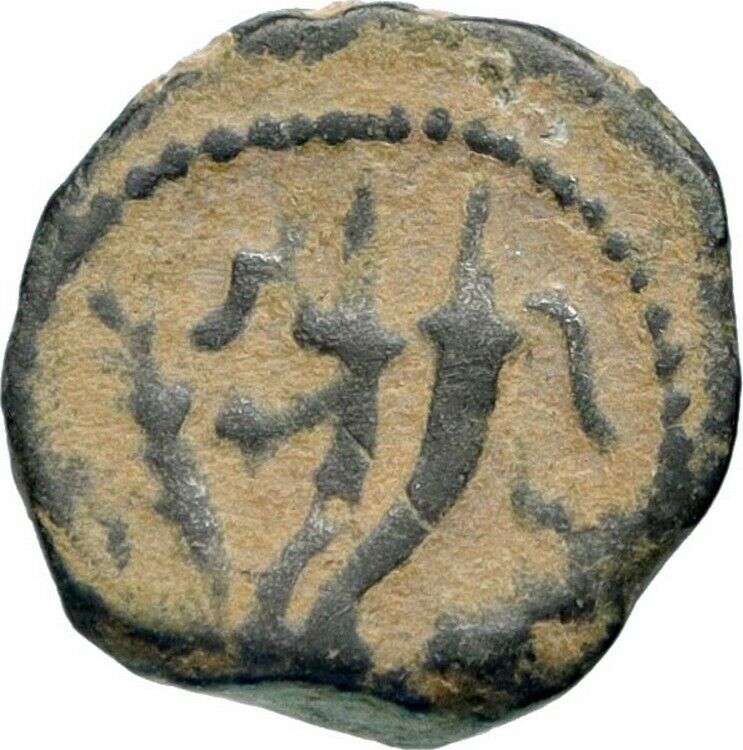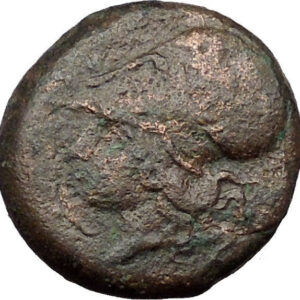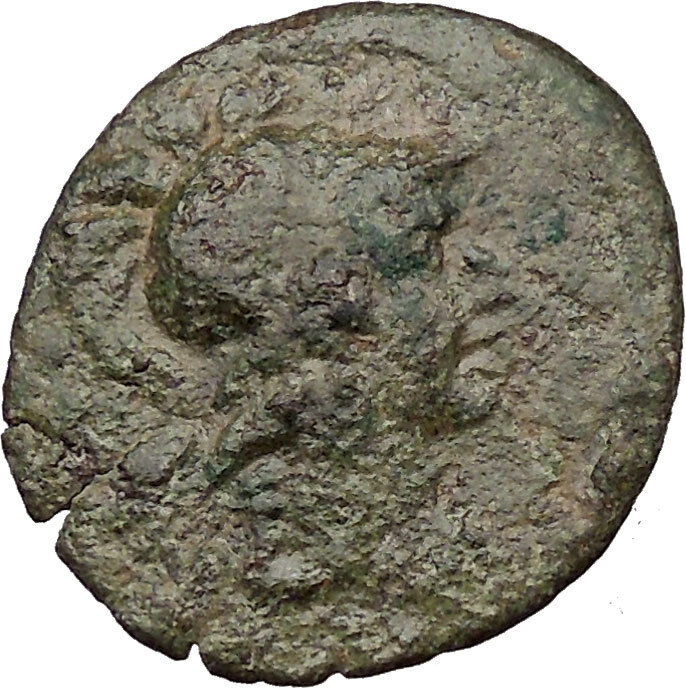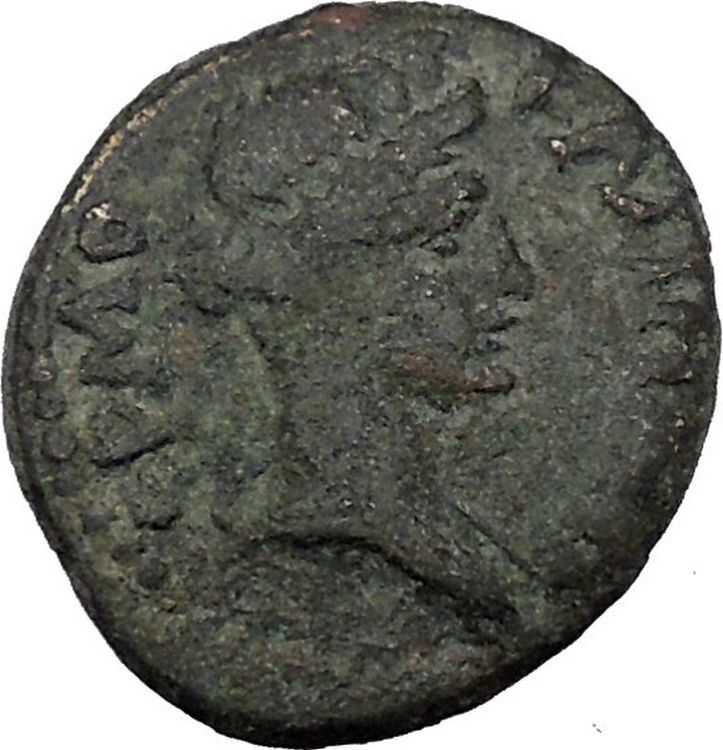|
Greek city of Amastris in Paphlagonia
Bronze 24mm (6.89 grams) Struck under Mithradates VI the Great circa 105-90 B.C. or circa 90-85 B.C.
Reference: HGC 7, 361; Sear 3675; SNG Black Sea 1315-1318; B.M.C. 13.85,9
Aegis, with Gorgon’s head at center.
Nike advancing right, carrying palm-branch; AMAΣ-TPEΩΣ across field; monograms to left and to right.
Founded circa 300 B.C. on the site of the former Sesamos, Amastris became an important city and Black Sea port.
You are bidding on the exact item pictured, provided with a Certificate of Authenticity and Lifetime Guarantee of Authenticity.
In Ancient Greece, the Gorgoneion (Greek: Γοργόνειον) was originally a horror-creating apotropaic pendant showing the Gorgon’s head. It was assimilated by the Olympian deities Zeus and Athena: both are said to have worn it as a protective pendant. It was assumed, among other godlike attributes, as a royal aegis, by rulers of the Hellenistic age, as shown, for instance, on the Alexander Mosaic and the Gonzaga Cameo.
 Homer refers to the Gorgon on four occasions, each time alluding to the head alone, as if the creature had no body. Jane Ellen Harrison notes that “Medusa is a head and nothing more…a mask with a body later appended”. Up to the 5th century BC, the head was depicted as particularly ugly, with a protruding tongue, boar tusks, puffy cheeks, her eyeballs staring fixedly on the viewer and the snakes twisting all around her. Homer refers to the Gorgon on four occasions, each time alluding to the head alone, as if the creature had no body. Jane Ellen Harrison notes that “Medusa is a head and nothing more…a mask with a body later appended”. Up to the 5th century BC, the head was depicted as particularly ugly, with a protruding tongue, boar tusks, puffy cheeks, her eyeballs staring fixedly on the viewer and the snakes twisting all around her.
The direct frontal stare, “seemingly looking out from its own iconographical context and directly challenging the viewer”, was highly unusual in ancient Greek art. In some instances a beard (probably standing for streaks of blood) was appended to her chin, making her appear as an orgiastic deity akin to Dionysus.
Gorgoneia that decorate the shields of warriors on mid-5th century Greek vases are considerably less grotesque and menacing. By that time, the Gorgon had lost her tusks and the snakes were rather stylized. The Hellenistic marble known as the Medusa Rondanini illustrates the Gorgon’s eventual transformation into a beautiful woman.
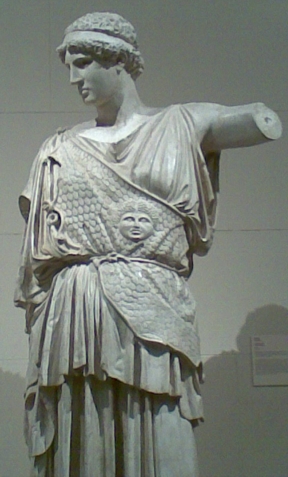 The aegis or aigis, as stated in the Iliad, is carried by Athena and Zeus, but its nature is uncertain. It had been interpreted as an animal skin or a shield, sometimes bearing the head of a Gorgon. There may be a connection with a deity named Aex or Aix, a daughter of Helios and a nurse of Zeus or alternatively a mistress of Zeus (Pseudo-Hyginus, Astronomica 2. 13). The aegis of Athena is referred to in several places in the Iliad. It produced a sound as from a myriad roaring dragons (Iliad, 4.17) and was borne by Athena in battle “… and among them went bright-eyed Athene, holding the precious aegis which is ageless and immortal: a hundred tassels of pure gold hang fluttering from it, tight-woven each of them, and each the worth of a hundred oxen.” The aegis or aigis, as stated in the Iliad, is carried by Athena and Zeus, but its nature is uncertain. It had been interpreted as an animal skin or a shield, sometimes bearing the head of a Gorgon. There may be a connection with a deity named Aex or Aix, a daughter of Helios and a nurse of Zeus or alternatively a mistress of Zeus (Pseudo-Hyginus, Astronomica 2. 13). The aegis of Athena is referred to in several places in the Iliad. It produced a sound as from a myriad roaring dragons (Iliad, 4.17) and was borne by Athena in battle “… and among them went bright-eyed Athene, holding the precious aegis which is ageless and immortal: a hundred tassels of pure gold hang fluttering from it, tight-woven each of them, and each the worth of a hundred oxen.”
Medusa, the gorgon, was beheaded by the hero Perseus, who thereafter used her head, which retained its ability to turn onlookers to stone, as a weapon until he gave it to the goddess Athena to place on her shield. In classical antiquity the image of the head of Medusa appeared in the evil-averting device known as the Gorgoneion. Gorgons were a popular image in Greek mythology, appearing in the earliest of written records of Ancient Greek religious beliefs such as those of Homer, which may date to as early as 1194-1184 BC. Because of their legendary and powerful gaze that could turn one to stone, images of the Gorgons were put upon objects and buildings for protection.
The modern concept of doing something “under someone’s aegis” means doing something under the protection of a powerful, knowledgeable, or benevolent source. The word aegis is identified with protection by a strong force with its roots in Greek mythology and adopted by the Romans; there are parallels in Norse mythology and in Egyptian mythology as well, where the Greek word aegis is applied by extension.
 In Greek mythology, Nike was a goddess who personified victory, also known as the Winged Goddess of Victory. The Roman equivalent was Victoria. Depending upon the time of various myths, she was described as the daughter of Pallas (Titan) and Styx (Water) and the sister of Kratos (Strength), Bia (Force), and Zelus (Zeal). Nike and her siblings were close companions of Zeus, the dominant deity of the Greek pantheon. According to classical (later) myth, Styx brought them to Zeus when the god was assembling allies for the Titan War against the older deities. Nike assumed the role of the divine charioteer, a role in which she often is portrayed in Classical Greek art. Nike flew around battlefields rewarding the victors with glory and fame. In Greek mythology, Nike was a goddess who personified victory, also known as the Winged Goddess of Victory. The Roman equivalent was Victoria. Depending upon the time of various myths, she was described as the daughter of Pallas (Titan) and Styx (Water) and the sister of Kratos (Strength), Bia (Force), and Zelus (Zeal). Nike and her siblings were close companions of Zeus, the dominant deity of the Greek pantheon. According to classical (later) myth, Styx brought them to Zeus when the god was assembling allies for the Titan War against the older deities. Nike assumed the role of the divine charioteer, a role in which she often is portrayed in Classical Greek art. Nike flew around battlefields rewarding the victors with glory and fame.
Nike is seen with wings in most statues and paintings. Most other winged deities in the Greek pantheon had shed their wings by Classical times. Nike is the goddess of strength, speed, and victory. Nike was a very close acquaintance of Athena, and is thought to have stood in Athena’s outstretched hand in the statue of Athena located in the Parthenon. Nike is one of the most commonly portrayed figures on Greek coins.
Names stemming from Nike include amongst others: Nicholas, Nicola, Nick, Nikolai, Nils, Klaas, Nicole, Ike, Niki, Nikita, Nika, Niketas, and Nico.

Mithridates VI or Mithradates VI (Greek: Μιθραδάτης), from Old Persian Mithradatha, “gift of Mithra”; 134-63 BC, also known as Mithradates the Great (Megas) and Eupator Dionysius, was king of Pontus and Armenia Minor in northern Anatolia (now Turkey) from about 120-63 BC. Mithridates is remembered as one of the Roman Republic’s most formidable and successful enemies, who engaged three of the prominent generals from the late Roman Republic in the Mithridatic Wars: Lucius Cornelius Sulla, Lucullus and Pompey. He was also the greatest ruler of the Kingdom of Pontus.
 Amasra (from Greek Amastris Ἄμαστρις, gen. Ἀμάστριδος) is a small Black Sea port town in the Bartın Province, Turkey. The town is today much appreciated for its beaches and natural setting, which has made tourism the most important activity for its inhabitants. In 2010 the population was 6,500. Amasra (from Greek Amastris Ἄμαστρις, gen. Ἀμάστριδος) is a small Black Sea port town in the Bartın Province, Turkey. The town is today much appreciated for its beaches and natural setting, which has made tourism the most important activity for its inhabitants. In 2010 the population was 6,500.
Amasra has two islands: the bigger one is called Büyük ada (Great Island) while the smaller one is called Tavşan adası (Rabbit Island).
History
Situated in the ancient region of Paphlagonia, the original city seems to have been called Sesamus (Greek: Σήσαμος), and it is mentioned by Homer in conjunction with Cytorus. Stephanus says that it was originally called Cromna; but in another place, where he repeats the statement, he adds, as it is said; but some say that Cromna is a small place in the territory of Amastris, which is the true account. The place derived its name Amastris from Amastris, the niece of the last Persian king Darius III, who was the wife of Dionysius, tyrant of Heraclea, and after his death the wife of Lysimachus. Four small Ionian colonies, Sesamus, Cytorus, Cromna, also mentioned in the Iliad,[6] and Tium, were combined by Amastris, after her separation from Lysimachus, to form the new community of Amastris, placed on a small river of the same name and occupying a peninsula. According to Strabo, Tium soon detached itself from the community, but the rest kept together, and Sesamus was the acropolis of Amastris. From this it appears that Amastris was really a confederation or union of three places, and that Sesamus was the name of the city on the peninsula. This may explain the fact that Mela mentions Sesamus and Cromna as cities of Paphlagonia, while omitting Amastris.
The territory of Amastris produced a great quantity of boxwood, which grew on Mount Cytorus. Its tyrant Eumenes presented the city of Amastris to Ariobarzanes of Pontus in c. 265-260 BC rather than submit it to domination by Heraclea, and it remained in the Pontic kingdom until its capture by Lucius Lucullus in 70 BC in the second Mithridatic War. The younger Pliny, when he was governor of Bithynia and Pontus, describes Amastris, in a letter to Trajan, as a handsome city, with a very long open place (platea), on one side of which extended what was called a river, but in fact was a filthy, pestilent, open drain. Pliny obtained the emperor’s permission to cover over this sewer. On a coin of the time of Trajan, Amastris has the title Metropolis. It continued to be a town of some note to the seventh century of our era. From Amasra got its name an important place of Constantinople, the Amastrianum.
The city was not abandoned in the Byzantine Era, when the acropolis was transformed into a fortress and the still surviving church was built. It was sacked by the Rus during the First Russo-Byzantine War in the 830s. Speros Vryonis states that in the 9th century a “combination of local industry, trade, and the produce of its soil made Amastris one of the more prosperous towns on the Black Sea.” In the 13th century Amasra exchanged hands several times, first becoming a possession of the Empire of Trebizond in 1204, then at some point in the next ten years being captured by the Seljuk Turks, until finally in 1261, in her bid to monopolize the Black Sea trade, the town came under the control of the Republic of Genoa. Genoese domination ended when the Ottoman Sultan Mehmed II conquered the whole Anatolian shores of the Black Sea.
The bishopric of Amastris was established early: according to Eusebius, its congregation received a letter from the second-century bishop, Dionysius, Bishop of Corinth, wherein he names their bishop, one Palmas. The see was initially a suffragan of the metropolitan of Gangra, capital of the Roman province of Paphlagonia, but in the late 8th century its bishop obtained from the Byzantine Emperor its elevation to the rank of autocephalous archeparchy. It is listed as such in the Notitia Episcopatuum attributed to Basil the Armenian (c. 840) and in that of Leo VI the Wise (early 10th century). In the middle of the 10th century it obtained the rank of metropolitan see without suffragans, a rank it held until, due to the diminution in the number of Christians in the area, it was suppressed. From the 14th century to the second half of the 15th, the town was also the seat of a bishopric of the Latin Church. No longer a residential bishopric, Amastris is today listed by the Catholic Church as a titular see.
Main sights
With its architectural heritage, Amasra is a member of the Norwich-based European Association of Historic Towns and Regions.
Archaeological Museum: there is a fine medium-sized archaeological museum by the sea with remains from both land and underwater. Of particular interest is a statue of the snake god Glykon, a fraudulent creation of a local entrepreneur during Roman imperial times.
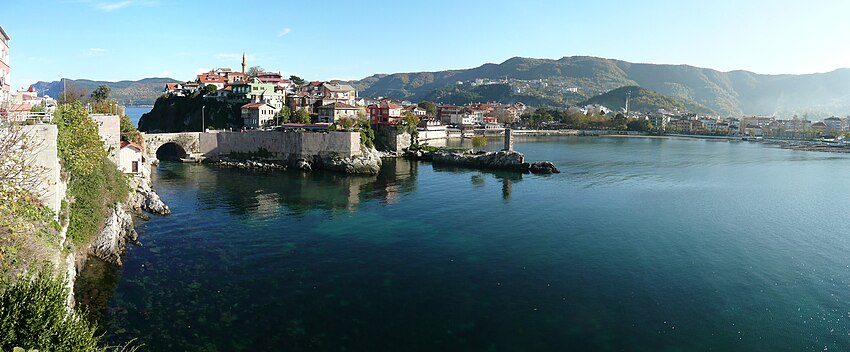
Panoramic view of the town
Amasra Castle
Amasra Castle was built during the Roman period. The walls of the castle were built by the Byzantines. The front walls and gates were built by the Genoese in the 14th and 15th centuries. Though located on a narrow peninsula, a tunnel under the castle leads to a fresh water pool.
Church Mosque
Built as a Byzantine church in the 9th century AD. The church is a small chapel and its narthex section consists of three parts. After Fatih Sultan Mehmet conquered Amasra in 1460, it was converted to a mosque. The church mosque was closed to prayer in 1930.

Amasra church mosque
Bird’s Rock Road Monument
Bird’s Rock Road Monument was created between AD 41-54 by order of Bithynia et Pontus Governor Gaius Julius Aquila. It was a resting place and monument. At the time when Claudius was Rome’s Emperor, Aguila was the commander of the building army in the eastern provinces. It is located a little outside Amasra on the road in, it is easily accessed by steps leading from the roadside.

Bird’s Rock Road Monument
Power Station
In 2009 a coal-fired power station of 2640 MWe (or 1200 MWe) was proposed. It will have a super critical boiler, will utilise a nearby bituminous coal mine and is to be seawater cooled. An application has been made to acquire 49-year long-term concession rights for exploitation of local bituminous proven coal reserves of approximately 573 million metric tons. Concerns have been raised about the effect on air quality, marine ecology and ash
|





 Homer refers to the Gorgon on four occasions, each time alluding to the head alone, as if the creature had no body. Jane Ellen Harrison notes that “Medusa is a head and nothing more…a mask with a body later appended”. Up to the 5th century BC, the head was depicted as particularly ugly, with a protruding tongue, boar tusks, puffy cheeks, her eyeballs staring fixedly on the viewer and the snakes twisting all around her.
Homer refers to the Gorgon on four occasions, each time alluding to the head alone, as if the creature had no body. Jane Ellen Harrison notes that “Medusa is a head and nothing more…a mask with a body later appended”. Up to the 5th century BC, the head was depicted as particularly ugly, with a protruding tongue, boar tusks, puffy cheeks, her eyeballs staring fixedly on the viewer and the snakes twisting all around her. The aegis or aigis, as stated in the Iliad, is carried by Athena and Zeus, but its nature is uncertain. It had been interpreted as an animal skin or a shield, sometimes bearing the head of a Gorgon. There may be a connection with a deity named Aex or Aix, a daughter of Helios and a nurse of Zeus or alternatively a mistress of Zeus (Pseudo-Hyginus, Astronomica 2. 13). The aegis of Athena is referred to in several places in the Iliad. It produced a sound as from a myriad roaring dragons (Iliad, 4.17) and was borne by Athena in battle “… and among them went bright-eyed Athene, holding the precious aegis which is ageless and immortal: a hundred tassels of pure gold hang fluttering from it, tight-woven each of them, and each the worth of a hundred oxen.”
The aegis or aigis, as stated in the Iliad, is carried by Athena and Zeus, but its nature is uncertain. It had been interpreted as an animal skin or a shield, sometimes bearing the head of a Gorgon. There may be a connection with a deity named Aex or Aix, a daughter of Helios and a nurse of Zeus or alternatively a mistress of Zeus (Pseudo-Hyginus, Astronomica 2. 13). The aegis of Athena is referred to in several places in the Iliad. It produced a sound as from a myriad roaring dragons (Iliad, 4.17) and was borne by Athena in battle “… and among them went bright-eyed Athene, holding the precious aegis which is ageless and immortal: a hundred tassels of pure gold hang fluttering from it, tight-woven each of them, and each the worth of a hundred oxen.” In Greek mythology, Nike was a goddess who personified victory, also known as the Winged Goddess of Victory. The Roman equivalent was Victoria. Depending upon the time of various myths, she was described as the daughter of Pallas (Titan) and Styx (Water) and the sister of Kratos (Strength), Bia (Force), and Zelus (Zeal). Nike and her siblings were close companions of Zeus, the dominant deity of the Greek pantheon. According to classical (later) myth, Styx brought them to Zeus when the god was assembling allies for the Titan War against the older deities. Nike assumed the role of the divine charioteer, a role in which she often is portrayed in Classical Greek art. Nike flew around battlefields rewarding the victors with glory and fame.
In Greek mythology, Nike was a goddess who personified victory, also known as the Winged Goddess of Victory. The Roman equivalent was Victoria. Depending upon the time of various myths, she was described as the daughter of Pallas (Titan) and Styx (Water) and the sister of Kratos (Strength), Bia (Force), and Zelus (Zeal). Nike and her siblings were close companions of Zeus, the dominant deity of the Greek pantheon. According to classical (later) myth, Styx brought them to Zeus when the god was assembling allies for the Titan War against the older deities. Nike assumed the role of the divine charioteer, a role in which she often is portrayed in Classical Greek art. Nike flew around battlefields rewarding the victors with glory and fame.
 Amasra (from Greek Amastris Ἄμαστρις, gen. Ἀμάστριδος) is a small Black Sea port town in the Bartın Province, Turkey. The town is today much appreciated for its beaches and natural setting, which has made tourism the most important activity for its inhabitants. In 2010 the population was 6,500.
Amasra (from Greek Amastris Ἄμαστρις, gen. Ἀμάστριδος) is a small Black Sea port town in the Bartın Province, Turkey. The town is today much appreciated for its beaches and natural setting, which has made tourism the most important activity for its inhabitants. In 2010 the population was 6,500.




